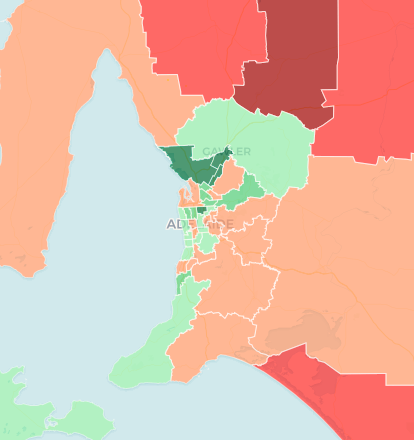South Australia is currently undergoing a redistribution of its state electoral boundaries. The redistribution kicked off late last year, with the first round of submissions closing in April.
The Commission has released current population figures as of February 2020, and projected electors as of June 2022. Each electorate is required to fall within 10% of the average.
The data shows how electorates outside of Adelaide are consistently under quota and creates a dilemma for the Commission in drawing electorates in northern parts of the state.
Below the fold I have a map (similar to my NSW map from last week) and a breakdown of the quotas by region.
This map is based on the projected population figures, which tend to have greater variance than the 2020 data.
Three electorates are projected to be more than 10% under the quota as of 2022: Flinders, Giles and Stuart. The neighbouring seat of Frome is projected to be 9.7% under quota. That’s a contiguous block of four seats collectively 46% under quota. Effectively there are only 3.5 seats’ worth of voters in this area.
Each of these four seats includes one of these cities: Port Pirie, Port Lincoln, Port Augusta and Whyalla. This led to a subsequent round of submissions on how to deal with this specific problem, which closed last week.
Rural electorates in the south-east of the state also tend to be under-quota. Eight of these nine seats are due to be under quota, by a total of 33.5%.
So it seems very likely we will see at least one new seat created in Adelaide, with knock-on effects in regional areas. It seems likely that one of the four northern seats will be abolished, and the Commission will either need to put two of those “Iron Triangle” cities into one seat, or draw an electoral boundary through the centre of one of these cities.
As to Adelaide, there are 32 electorates in the city, 21 of which are projected to be over quota. No seat is projected to be under quota by more than 5%, but four seats are 10% or more over quota. Three of those four seats are in the north of the city: Taylor, Elizabeth and Light are projected to be collectively over quota by 45% by June 2022. These three seats are a contiguous block at the northern edge of the city. Enfield in central Adelaide is projected to be 10.1% over quota, while Kaurna in the south is projected to be 9.7% over.
So it seems likely we will see a new seat created on the northern fringe of Adelaide, and a rural seat further north abolished, with knock-on effects across all of South Australia.
The following table shows the overall quota figures for each region of South Australia:
| Region | Seats | 2020 variance | 2022 variance |
| Central Adelaide | 14 | 5.0 | 15.6 |
| Northern Adelaide | 10 | 58.8 | 58.8 |
| Northern SA | 6 | -43.6 | -49.1 |
| South-East SA | 9 | -36.7 | -33.5 |
| Southern Adelaide | 8 | 16.5 | 8.2 |
The first round of submissions has now closed and are available for viewing on the website. I haven’t had time to go through them all but if you have thoughts about them feel free to share them in the comments.
There’s also a whole other discussion to be had about the changes to the SA Constitution in 2017 which removed the “fairness clause” from the constitution and triggered a round of submissions about how the Commission should factor electoral fairness into its criteria in the absence of a constitutional requirement.




Ben, its worth noting that the Commisioners are still supposed to juggle some criteria that push in opposite directions. The 10% tolerance mandated by s 77 applies at a “relevant date” within 6 months before they publish the new boundaries, but the criteria in s 83 (now shorn of the “fairness” clause) still include:
(d) the feasibility of communication between electors affected by the redistribution and their parliamentary representative in the House of Assembly; and
(e) the nature of substantial demographic changes that the Commission considers likely to take place in proposed electoral districts between the conclusion of its present proceedings and the date of the expiry of the present term of the House of Assembly,
So (d) suggests that they should tend towards keeping the rural districts a bit below quota, but if they assume that the growth of city districts and the decline of rural ones will continue, (e) says they should push the numbers enrolled in the city ones down a bit below quota and those in the rural ones up a bit above it, all within the 10% tolerance of course. More heartburn coming for the Liberals, and Troy Bell and Geoff Brock? And a bit of a headache for the commissioners?
Comments are closed.